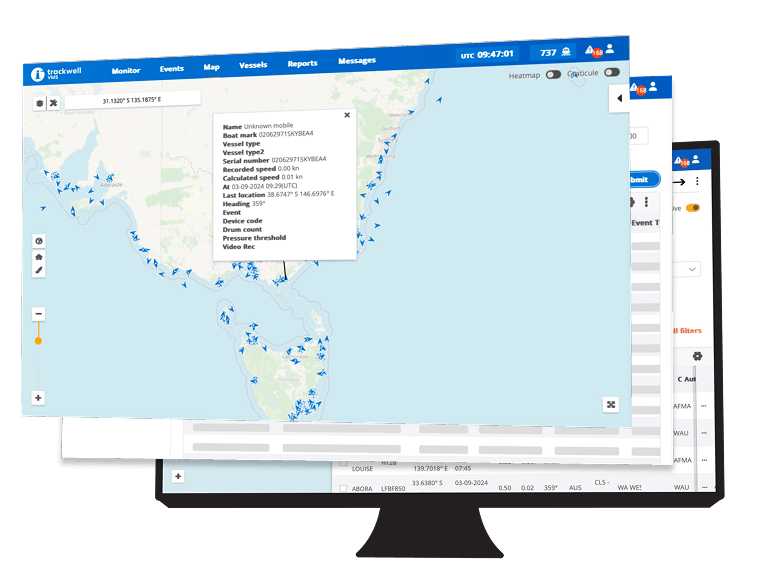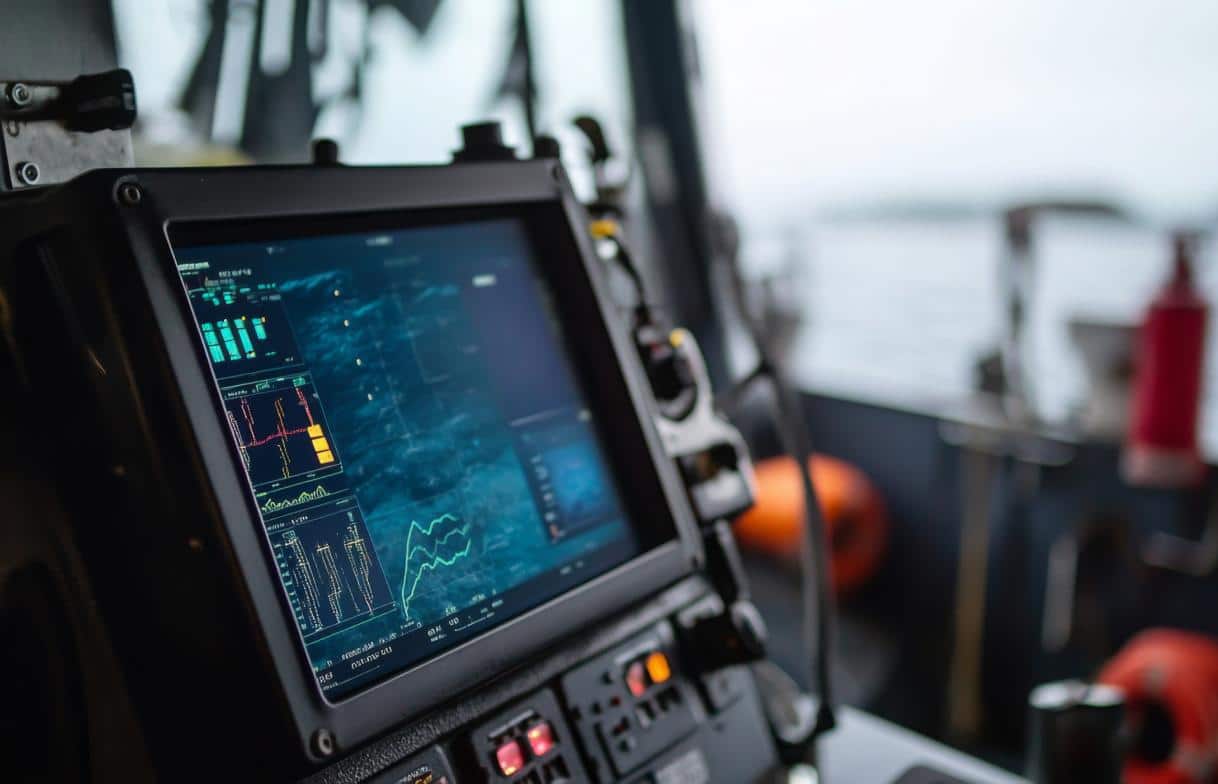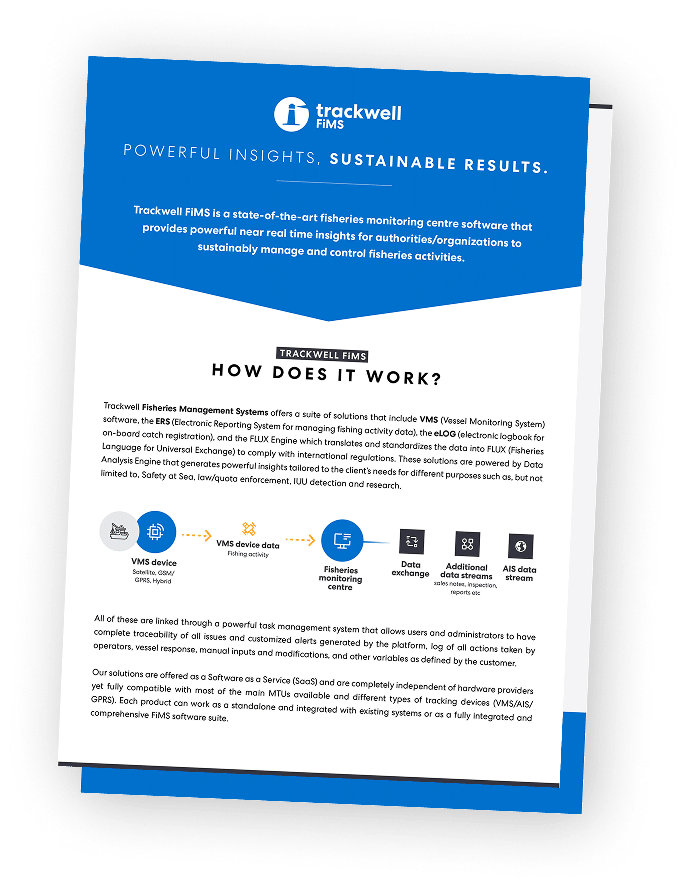Home » Fisheries Management Systems » Electronic Reporting System
The Electronic Reporting System (ERS) is a core module of Trackwell FiMS, our fully customizable Fisheries Management System. It can operate as a standalone product or be fully integrated into the Vessel Monitoring System (VMS) environment, offering both front-end and back-end components.
In most deployments, the ERS integrates with VMS, allowing users to compare electronic reporting data with vessel monitoring data to detect potential misreporting. Reports can be viewed alongside VMS streams, with vessel locations cross-checked against EEZ maps and fishing zones. The Monitoring Engine then generates alerts as required, improving oversight, ensuring compliance, and enhancing fisheries monitoring accuracy.


The front-end of Trackwell ERS provides a comprehensive user interface for all fisheries data: catch messages, e-logbooks, sales reports, and inspection reports. The interface is intuitive, web-based, and easy to navigate from desktop or mobile devices. Users can filter, select, and display data according to operational needs, streamlining workflows.
When vessels send catch messages, the system assembles them into a complete electronic logbook for the entire fishing trip. Both individual catch messages (North Atlantic Format, NAF) and complete logbook messages (Fisheries Language for Universal Exchange, FLUX) are supported.
Trackwell ERS handles all major electronic logbook message types (e.g., COE, CAT/DCA, COX, TRA, POR, DEP, CON) and supports all widely used communication methods, ensuring compatibility with diverse fleets and regulatory requirements.
Learn how Trackwell’s Electronic Reporting System (ERS) can support your organization’s fisheries monitoring and compliance efforts.
Contact our team to request a download link for our brochure.

When implemented as a standalone system the Trackwell Electronic Reporting System still provides many of the functionalities of a basic VMS software module. Vessel positions displayed on the map interface are the ones declared in the fishing activity messages and therefore not real time positioning.
Trackwell’s Electronic Reporting System (ERS) features a web-based platform with a clear and intuitive interface that can be accessed via desktop or mobile devices using any modern web browser. The Monitoring view is thoughtfully designed to help users easily navigate alerts and reported events, giving them a consolidated view of reporting-related issues and streamlining daily workflows.
Within the ERS environment, vessel locations shown on the map reflect positions as reported in electronic fishing activity messages, rather than real-time tracking data. The system supports standard navigational charts and can incorporate weather forecasts and ocean condition overlays. The interface offers tools for filtering vessels, managing personalized map views, and setting up geo-fences, allowing users to adapt the monitoring view to match reporting needs and regulatory requirements.
The Vessel positions displayed on the map interface are the ones declared in the fishing activity messages and therefore not real time positioning. It also integrates information from fishing licenses databases, certificates of seaworthiness, and other relevant data available to the customer to better perform their monitoring and enforcement of fishing regulations.
Trackwell ERS receives, stores, displays and forwards fishing activity reports coming from the onboard electronic logbooks or external databases synchronised with the system. The platform allows users to configure any number of monitoring request with an advanced alert mechanism, which the system displays and prioritize as monitoring issues. Alerts can also be defined according to criteria regarding fishing activity reporting regulations, such as catch on entry (COE), catch on exit (COX) etc. which are essential for sustainable fisheries management and the protection of marine resources.
The Electronic Reporting System (ERS) includes a comprehensive vessel registry that maintains all key information about the fleet. The registry interface enables users to search, view, and update vessel records, including details such as vessel name, reported positions, historical reports, registrations, fishing licenses, authorizations, and permits. The system supports manual entry of new vessels participating in reporting programs and can synchronize automatically with national vessel registries if required.
License and permit information is seamlessly incorporated into the vessel registry and can synchronize automatically with external databases when needed. The system enables authorized personnel to manage all aspects of fishing licenses and permits — from issuing and status updates to suspensions — offering flexibility for enforcement and compliance activities.
The system makes it easy to generate both standard and tailored reports. Authorized users can apply various filters to produce reports that meet specific needs, and new custom reports can be created based on organizational requirements. All reports are exportable in common formats such as Excel, PDF, and Word.
The system can function as a standalone solution or integrate seamlessly into the broader Trackwell VMS platform. It receives, stores, processes, and forwards fishing activity reports, sales notes, and other fisheries-related data. Information can be collected from Trackwell eLog, third-party electronic logbooks, or external sources, providing flexibility to meet each customer’s operational and reporting needs.
The system ensures that all user accounts are protected using username and password credentials, in line with industry-standard security practices. Access is controlled through a flexible role-based system that supports predefined roles such as admin, user, and guest, as well as custom roles tailored to organizational needs. In addition, an audit trail is maintained to record user actions within the system, supporting accountability and oversight.
Our electronic reporting system enables organizations such as RFMOs or multi-state authorities to securely share fisheries information while restricting access to defined subsets of data. Where needed, tailored governance frameworks can be introduced to meet specific operational or regulatory requirements.
Trackwell ERS is built to meet the stringent security and reliability standards required by governments and Regional Fisheries Management Organizations (RFMOs). Its architecture ensures that sensitive data is safeguarded at every level, providing dependable performance and protection for fisheries monitoring operations.In addition to robust security, the system is supported by 24/7/365 assistance, delivering high availability with uptime exceeding 99.95%. Comprehensive disaster recovery and backup protocols further ensure continuity, even in the face of unexpected disruptions.
Designed to flexibly support fleets of all sizes, Trackwell ERS can manage anything from national to international operations, whether a few vessels or thousands. There are no limits on the number of users or agencies, making it suitable for small authorities and large multi-agency setups alike.
The Trackwell ERS solution offers seamless integration with the FLUX Engine, enabling automated distribution of fisheries-related reports and data via the FLUX network. This powerful back-end component can be implemented alongside ERS, VMS, or other FMC systems as required. In addition, ERS allows connectivity and data transfers to external systems, ensuring smooth information flow between platforms.
Trackwell ERS is designed to meet international standards for fisheries data exchange. It supports all relevant communication protocols and message formats established by the EU, regional organizations (such as NEAFC, NAFO, SEAFO, ICCAT), and in cross-border agreements. This ensures that fisheries authorities and management bodies can reliably exchange data with national and international partners.
Trackwell’s FiMS Electronic Reporting System (ERS) is a flexible and scalable solution built to adapt to the evolving landscape of fisheries management. Our platform supports a wide range of communication protocols and report formats, providing authorities with the tools they need to stay ahead of regulatory requirements and operational demands. This forward-thinking design ensures that your organization can manage current challenges while being prepared for future needs.
About us
Trackwell FiMS is a state of the art software that provides powerful near real-time insights to sustainably manage and control fisheries activities.

Fisheries Management System
FiMS is used by fisheries authorities, coastguards, and navies for surveillance, search and rescue, resource management, and fisheries control.
Helpful links